The days of relying on traditional advertising methods are long gone. As we all know, online is the place to be if you want to reach audiences more closely. Rather than hoping people will see your distant, static billboard by chance – you can guarantee to pop up directly on their newsfeed.
Advertising on social media sites is effective as the ads fit organically and seamlessly into the platform. For start-ups and medium sized businesses, this shift has meant greater potential reach and less budget spending.
In the UK, it was reported that 73% of internet users use Facebook. This begs the questions: what do Facebook ads offer? What makes Facebook advertising more effective than any other form of advertising? We shall cover that, along with many tips on how to get the best results from Facebook ads.
Table of Contents
How Do Facebook Ads Work?
Many websites and social media platforms do not require a subscription fee. To maintain them as free services, companies depend on high traffic as a valuable enticement for attracting advertisers. Last year, Facebook generated 69.7 billion US dollars from advertising alone.
This new place where users are spending hours and hours daily, has overhauled the entire field of advertising. This is because of their unique features that other traditional ads simply do not offer.

What Makes Facebook Ads Unique?
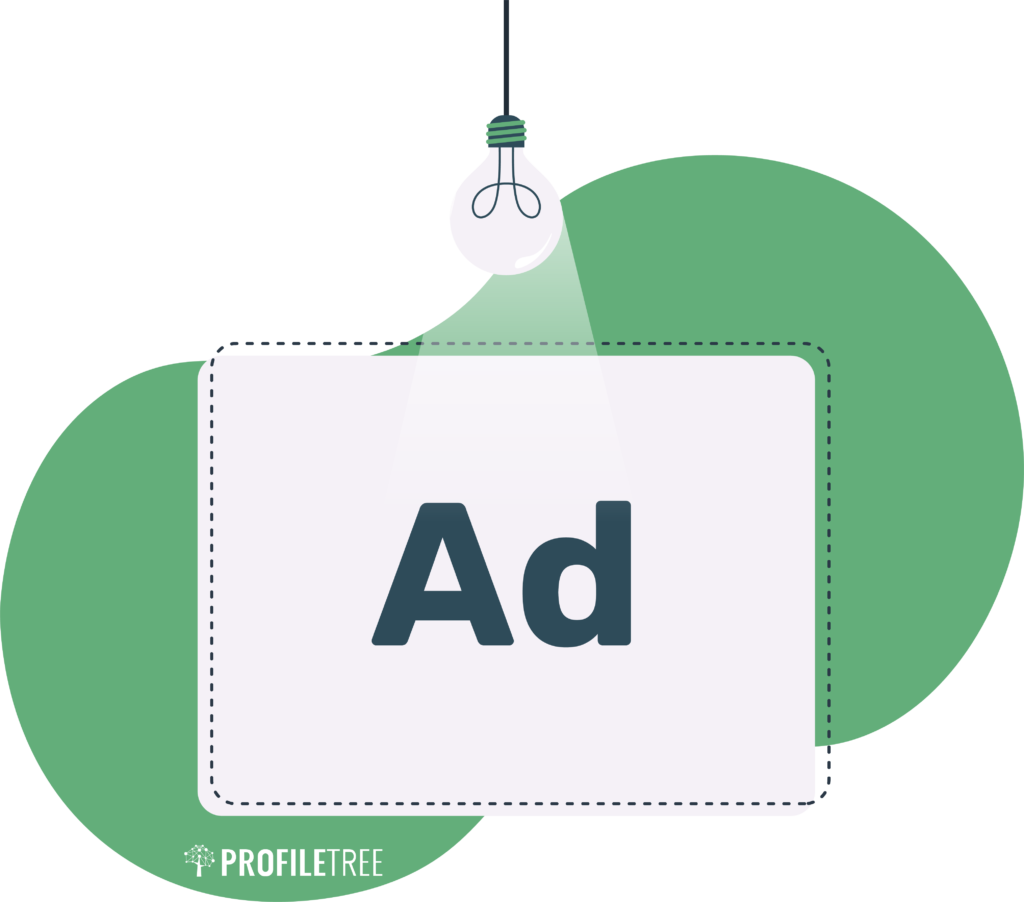
Diversity and High Traffic
Being the platform with the highest number of daily active users, Facebook is truly a gold mine for advertisers.
High traffic is something that every advertiser wants to benefit from. The higher the number of visitors, the bigger the return of investment will be.
Plus, the most special characteristic of this vast audience is their diversity. No matter what the demographics or attributes of your target audience are – they are present on Facebook. This is one unique property that distinguishes Facebook from other social media platforms as they are much more tailored to suit specific demographics.
Targeting: You Are What You Like
Targeting is what really made digital ads revolutionary.
Before the age of Facebook ads, advertising was random and only dependent on chance and repetition. This made its efficiency wear out, as people were seeing ads for products or services that they weren’t interested in. Therefore, ads simply became ‘white noise’ that people had learned to block out, unless they were of an extremely high, viral-worthy calibre to catch a person’s attention.
Today, Facebook ads are anything but random. Users only see ads for products that they are most likely to be interested in.
How does that happen? Well, you are what you like.
Ever go on Facebook and see an ad that almost spooks you out because it’s so specific to you? That’s because Facebook knows what your preferences are based on the data you insert.
Facebook targets people based on their demographics, interests and behaviours – all of which can be captured from their profile and activity. Let’s take a closer look at what these actually mean:
- Demographics are used to reach people based on things such as education, employment, household, financial, income, language and lifestyle
- Interests reach specific audiences based on apps they use, posts they share on their timelines and pages they like
- Behaviours relate to purchase behaviours, intents and device usage
By keeping track of this information, Facebook can reach a highly defined audience who are most likely to engage with your ad.
Different Digital Advertising Objectives
Facebook ads manager is indeed a smart and precise marketing tool.
In addition to targeting, Facebook considers the advertiser’s marketing objectives. This means that not only is the technology so advanced that it listens to user’s likes and dislikes, but also the advertiser’s.
Facebook ads give you many different options to set as advertising objectives:
- Brand awareness – boosts recognition of your brand
- Reach – displays your ad to as many people as possible within your target audience
- Traffic – increases the amount of people clicking on your site
- Engagement – if you want people to engage with your post or page
- App installs – encourages more people to download your app
- Video views – optimises to get more plays of your video ad
- Lead generation – helps you find more people interested in buying your product/service
- Messages – drives conversations with your business
- Catalogue sales – shows products from your ecommerce store’s catalogue
- Store visits – promotes your brick-and-mortar business locations to people that are nearby
Advertisers must choose based on the nature of their advertising campaign. Accordingly, Facebook will direct their ads to the right audience and in the best spot.
Types of Facebook Ads
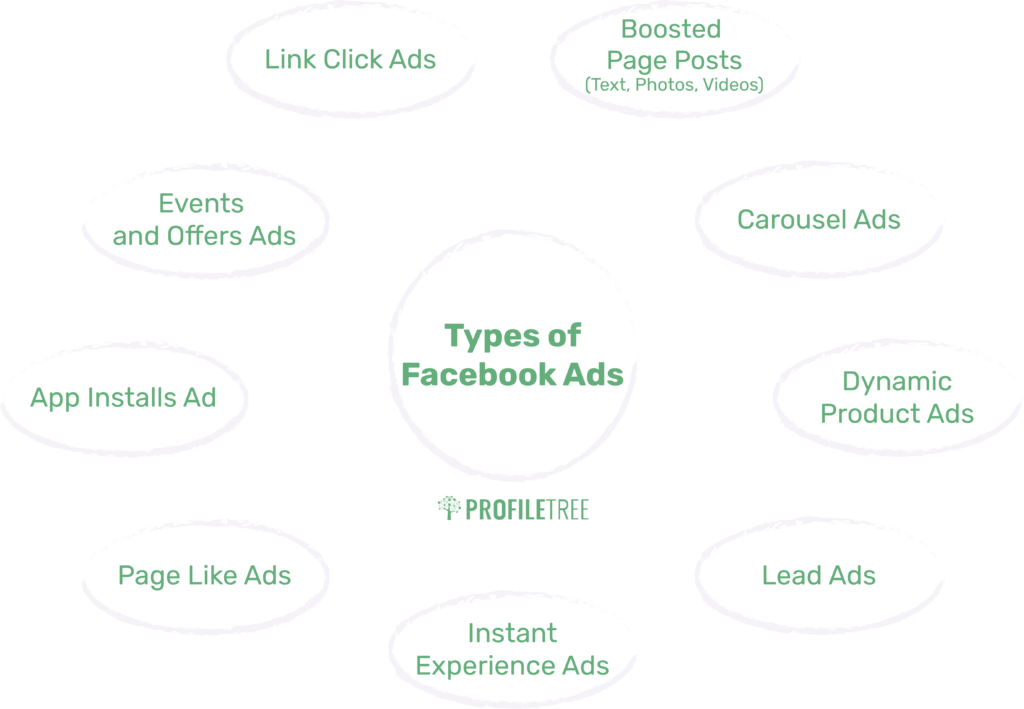
So, for all these advertising objectives, we have corresponding types of Facebook Ads. Let’s find out what they are, where they are placed, and their multiple purposes.
Link Click Ads
These are probably what comes to your mind when Facebook ads are mentioned. Link click ads promote any external link like websites, blog posts, or any other link that is not on Facebook.
Link click ads also feature an image, as shown in the picture below, or a video instead. They are placed on Facebook’s right column, or mobile and desktop newsfeed.
One of the main purposes of Facebook ads is driving traffic to a website, and link click ads fulfill this objective perfectly. Advertisers want more traffic to their websites for all the right reasons. As for their specifications, ad copy for link click ads are 90 characters long, while the headline is 25 characters and link description is 30. Finally, the recommended size for images is 1,200 x 628 pixels.
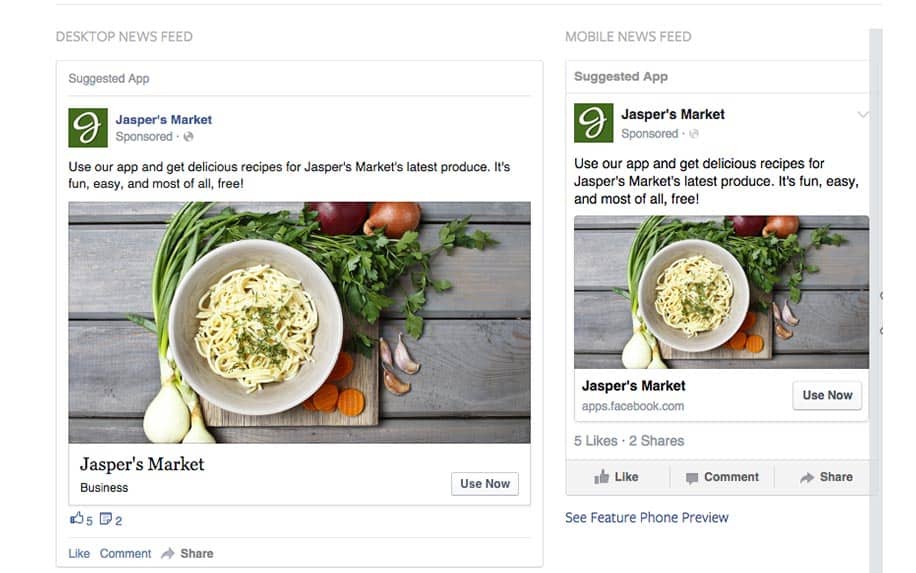
Boosted Page Posts (Text, Photos, Videos)
All your Facebook posts, texts, photos, or videos, can be ‘boosted’ or in other words, become sponsored Facebook ads.
If you choose to boost one of your posts, it will appear on the desktop/mobile newsfeed more often. You can choose your target audience based on their age, interests, location, etc. They can be inside or outside your own circle of viewers.
Boosted posts amplify the reach of your sponsored post, and consequently brings attention to your page. Therefore, you should always invest in boosting your best posts, especially those related to a new product, service, or event. Boosted posts have the same specifications as link click ads except that their ad copy text is unlimited.
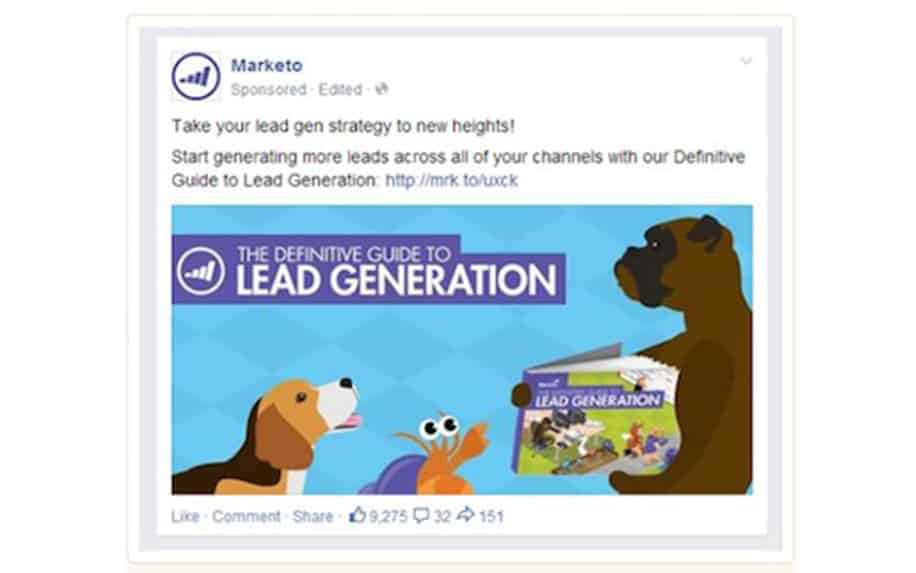
way to create Facebook ads. (Image credit: Instapage)
Carousel Ads
Carousel ads are designed to advertise and showcase multiple products. It is an ad format where several product images are displayed within an ad unit. The viewer can watch the products by swiping through them – hence why they replicate a carousel.
Carousel ads on Facebook have capacity for up to ten pictures. This type of Facebook ad is particularly useful for e-commerce businesses and the whole retail industry, where product visuals are the focus for attracting consumers.
They could be placed on desktop/mobile newsfeed; however, they are particularly popular on mobile devices due to their nature of scrolling. Specifications are similar to link click ads except that recommended image size is 1080 x 1080 or 600 x 600 pixels.
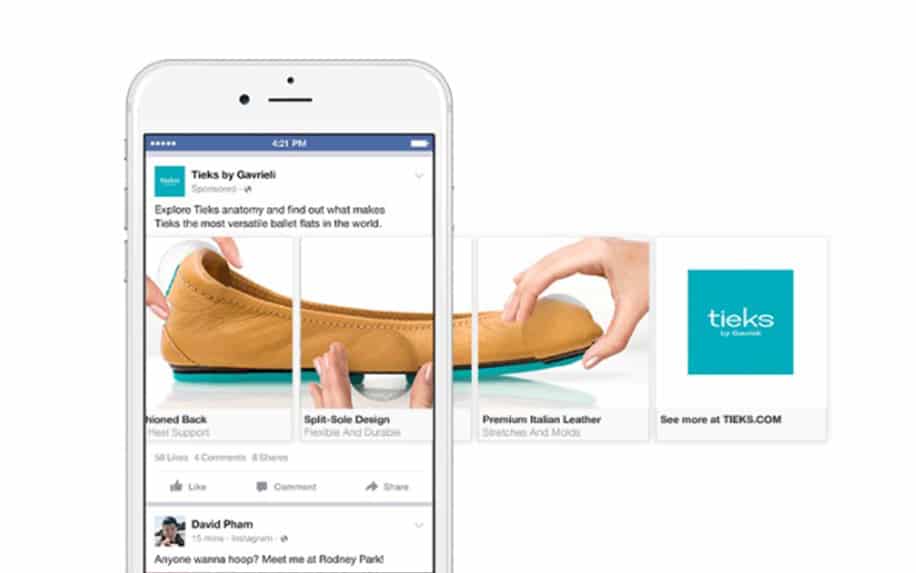
Dynamic Product Ads
Facebook dynamic ads automatically promote products to people who have expressed interest on your website, in your app or elsewhere on the Internet.
How do they work? A business simply uploads a catalogue of its products and sets up a campaign only once and then it will continue to run automatically for as long as the advertiser wishes.
Dynamic product ads’ strength point is that they are timely and free of hassle since they are automated. Specifications of these ads are the same as those of link click ads. This is another type of ad that works perfectly for e-commerce websites and retail. We must admit; Facebook ads really do favor the retail industry.
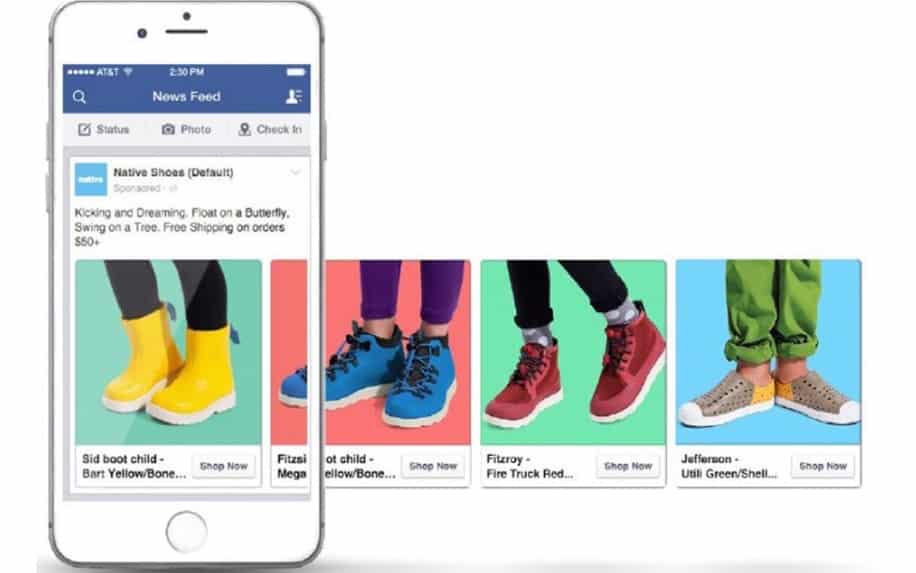
Lead Ads
These are the fastest and easiest way to get potential leads for your business. Without leaving Facebook, your audience can download your content, sign up for an offer or register for a newsletter.
The way it works is: people simply tap your ad and a form pops up. It is already pre-populated with their Facebook contact information and ready to be sent directly to you.
This ease of access immediately translates to a higher conversion rate. The information that a user hands over to you will be stored on your Facebook ads account. For industries that rely on lead generation, client contact information is very valuable.
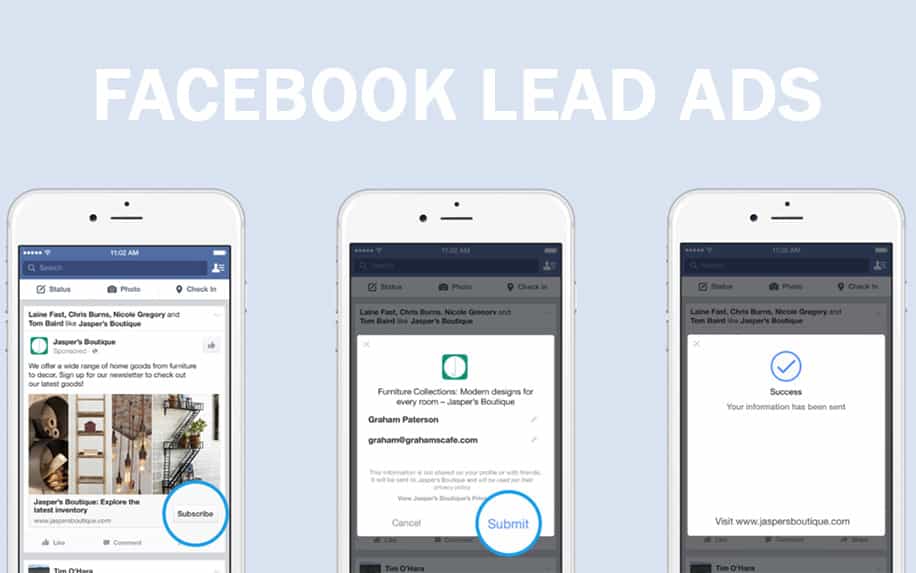
Instant Experience Ads
Instant experience ads, formerly known as ‘canvas’ ads, are designed to target mobile device users and immerse them in an eye-catching, full-screen ad experience. They load instantly, which boosts immediate engagement, with a load time up to 10 times faster than standard mobile web.
That gives us a clue of how significant mobile users are to Facebook. The audience can swipe through a carousel of images, tilt the image in different directions and/or zoom in or zoom out by moving their fingertips. Facebook instant experience ads could contain a full-screen image, a header with logo, an auto-play video, a product set etc.
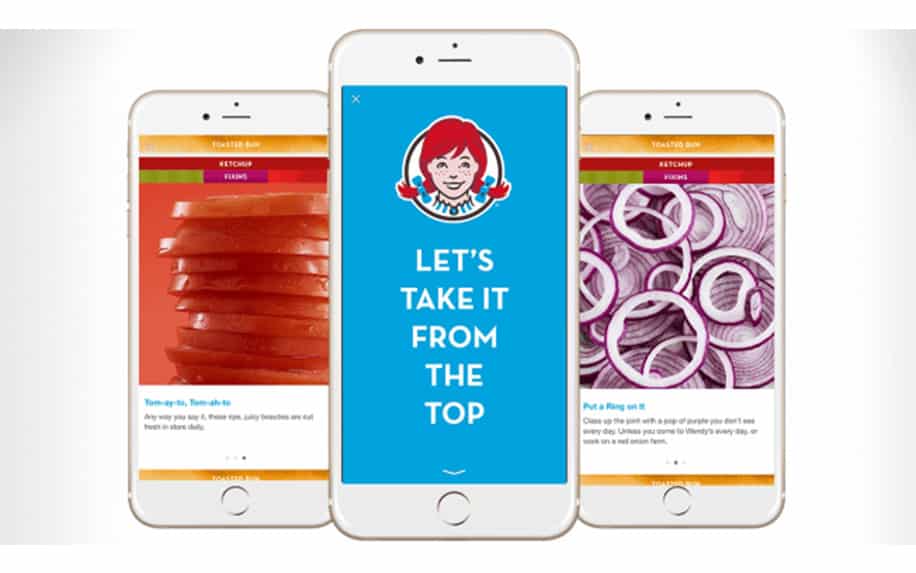
Page Like Ads
The purpose of page like ads is to gain higher awareness and engagement by attracting more people to your Facebook page.
Facebook will assess who has liked businesses similar to yours, or content that is similar to yours, and use this data to connect them to you. They appear on the mobile/desktop newsfeed or on the right column.
In addition, page like ads include a call to action for viewers to like your page while they are on the newsfeed, without even visiting your page. It is worthy to mention that you should not be looking for a high number of likes, but rather an audience with a high conversion potential and engagement level.
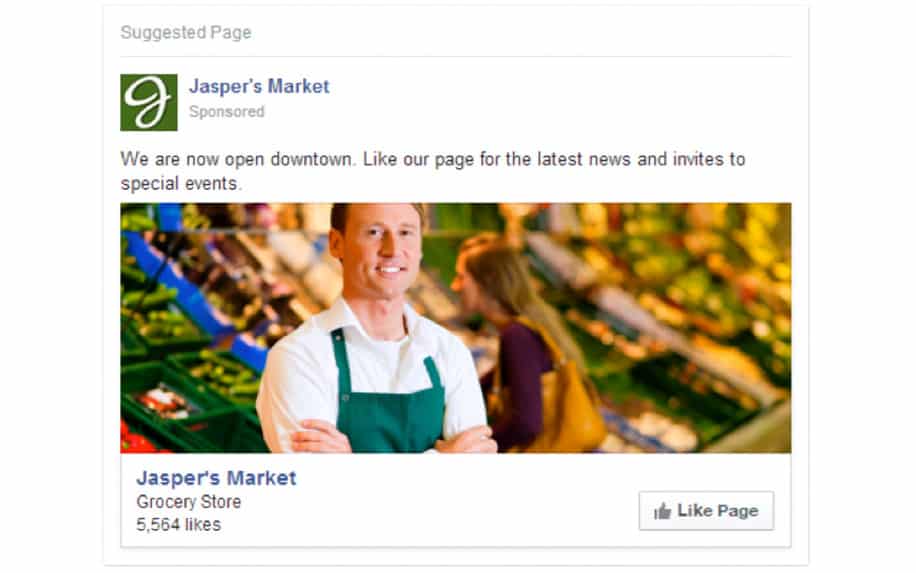
App Installs Ad
This type of ads is for advertisers who wish to increase the number of their app installs.
The ads are placed on users’ newsfeeds, on both mobile and desktop. You can showcase screenshots and videos, explain the benefits of your app and use customisable call-to-action buttons including ‘Shop Now’ or ‘Play Game’. When a user clicks on the ‘install’ button, the app store immediately pops up.
This is especially effective for mobile apps. For this ad format, you can also select if you want to target IOS/Android users, or if you want to target Wi-Fi users only.
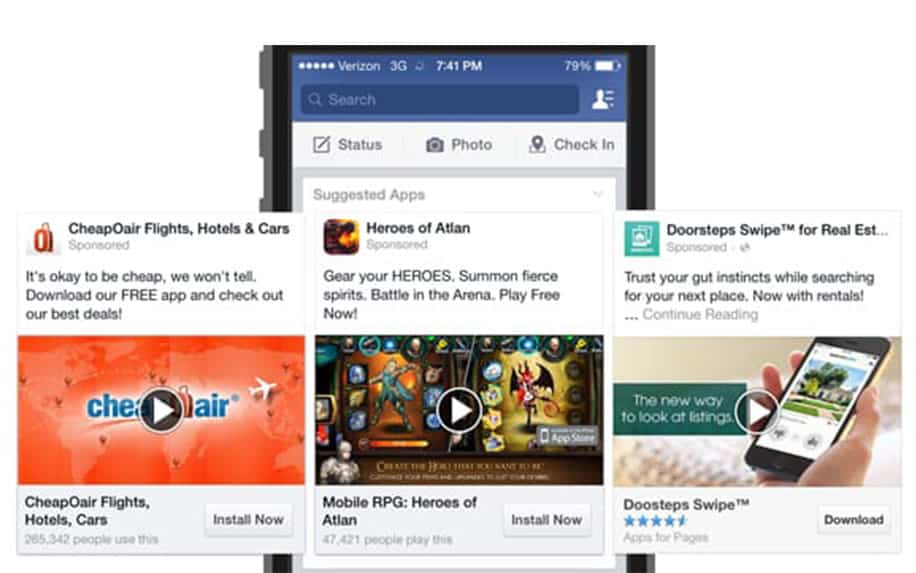
Events and Offers Ads
Event and offers ads are great for attracting people who have shown interest in similar events or offers.
Directing your ad towards near areas and locations is crucial for events and offer ads. You must target people who are likely to pay a visit to your business. Brick and mortar businesses and service-based ones can take advantage from these ads to reach the widest circle of potential customers.
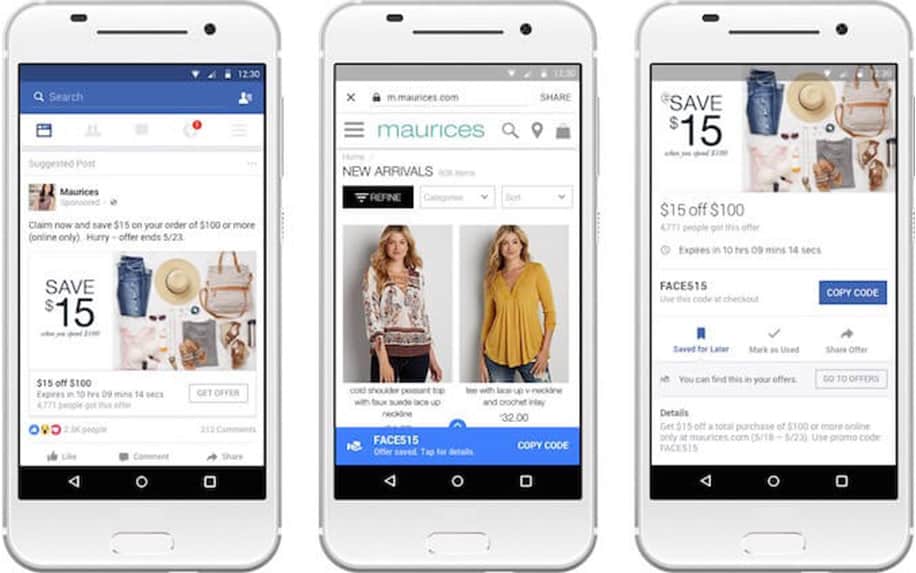
The Cost of Facebook Ads
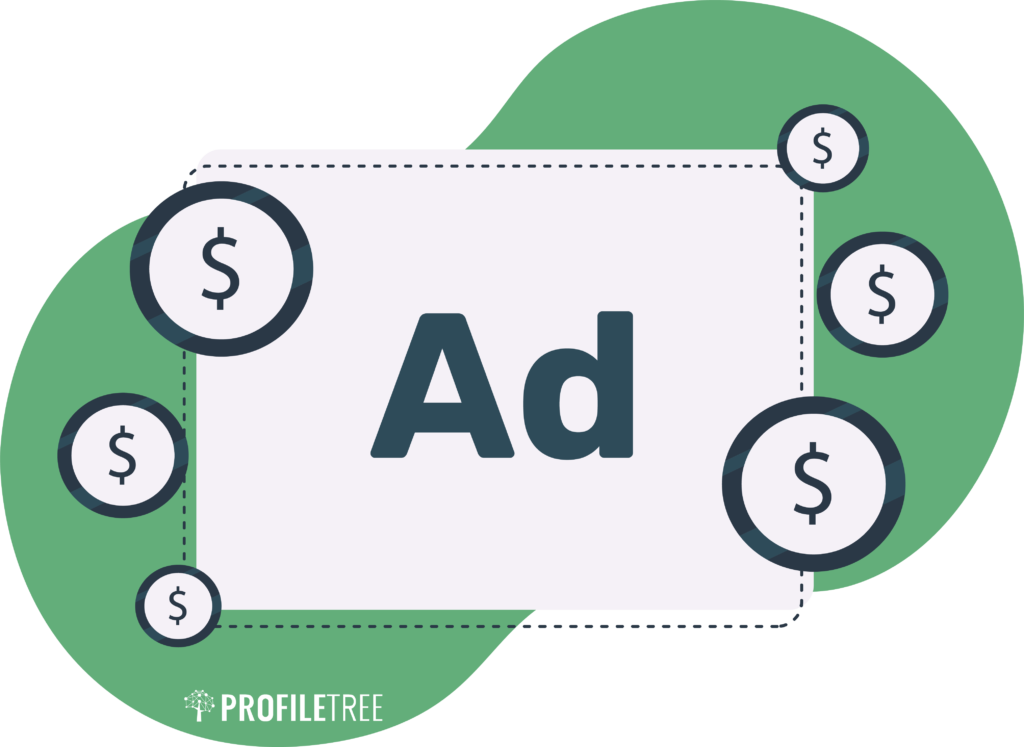
The budget of any kind of advertising depends on many different, and truly there is never one specific answer. It all depends on many factors. The price of Facebook ads depend on five main factors:
Advertising Objective
The advertising objective will determine how Facebook will charge the business owner. Meaning, if your target is getting users to ‘like’ your page, then Facebook will charge you for every like your ad gains.
The four methods for payment are cost per click, cost per impression, cost per conversion, and cost per like. Cost per click is literal for paying every time someone clicks on the ad. No matter what the result is, positive or negative – if someone clicks – the advertiser pays.
Cost per impression means the advertiser will pay for every 1000 impressions for their ad. This is why it is cheaper compared to the cost per click option. When it comes to the cost per conversion option, the advertiser pays for what they define as their conversion. This conversion could be a click, a sale, a form submission etc.
Finally, the cost per like module is self-explainable; Facebook charges the advertiser for every like the ad gets.
Bidding Type and Amount
Facebook ads are like those old antiques sold at auctions. Since advertisers are competing for viewers, there is a limit which Facebook sets to the number of ads seen by each user.
Therefore, bidding seems to be a fair way to enhance the advertiser’s and the user’s experience. This is also why the winner of this auction is not the bidder with the highest rate. In addition to the price an advertiser is willing to pay, Facebook bidding takes the quality of the ad and its relevance into consideration.
Facebook’s priority is to ensure that the platform stays friendly to its users. This will not happen if the quality of the ads the users see is poor.
Audience
Facebook selects the best person to show your ad to according to the user’s behavior and your advertising objective.
For example, if your objective is to get traffic, Facebook will choose the ‘clicky’ person to show your ad to.
If your objective is to get leads, Facebook will choose the person most likely to convert. With the exception of rare cases – the smaller the pool of your audience is – the higher the cost will be.
Ad Quality
As previously mentioned, the price of an ad is closely related to its quality. The natural question should be: how does Facebook measure the quality of an ad? The two factors which determine that are its relevance score and its click-through rate.
On a scale of 1 to 10, Facebook measures every ad’s relevancy to the audience the advertiser is targeting. The more relevant the ad is, the lower the cost would be.
As users interact with an ad, its relevancy score will continue to change. If the feedback is positive, the score gets better and vice versa.
Moreover, the feedback will affect an ad’s click-through rate; its number of clicks divided by the number of impressions. A higher click-through rate means that the ad is relevant to the target audience and that it adds value to them.
Industry and Season
Since every industry has its unique market qualities, the prices of Facebook ads differ according to the nature of the market. One cannot expect that the cost per conversion for Rolex is the same for a small local store.
Moreover, the time of the year can affect how much users will pay. Some seasons like Christmas or Black Friday are generally more expensive, while for specific industries, certain times of the year are usually busier.
9 Top Tips for Advertising on Facebook
- Make your ad stand out. Make it emotionally and visually engaging.
- Use less text in ads which include a photo. Make the visual aspect the priority of your ad.
- Ensure the ad’s text is meaningful, clear and witty.
- Establish a bid strategy and budget.
- Tailor your ads to be appealing to your target audience – not just to you.
- Keep your forms and ads short and straightforward.
- Include a clear call-to-action.
- Plan the customer journey carefully, especially the page they will land on once they click on an external link.
- Facebook Insights is a powerful tool, so use it to measure your performance.
Facebook ads are diverse, and they have huge potential. Crafting high quality ads can be life-changing to a business. A good-looking brand image cannot exist without a solid advertising strategy on Facebook. Knowing who a business wants to speak to and the right way to deliver are key to a successful social media advertising campaign.
Facebook vs. Other Paid Social Options: A KPI Showdown
Choosing the right platform for your paid social advertising can be a head-scratcher. While Facebook reigns supreme in user base and reach, other contenders like Instagram, Twitter, LinkedIn, and TikTok offer unique strengths and niches. Let’s dive into a comparative analysis based on key performance indicators (KPIs) to help you navigate the paid social landscape like a pro:
Reach and Impressions:
- Facebook: Boasts the largest user base (2.91 billion monthly active users) and delivers broad reach, particularly for B2C campaigns.
- Instagram: Leads in visual engagement with a younger audience (60% under 34), ideal for lifestyle and influencer marketing.
- Twitter: Offers real-time engagement and news-oriented demographics, perfect for B2B and thought leadership campaigns.
- LinkedIn: Stands out for professional reach and targeting, ideal for recruitment and B2B marketing.
- TikTok: Explodes with Gen Z and millennial engagement, ideal for viral trends and youth-oriented brands.
Cost per Click (CPC) and Conversions:
- Facebook: Generally, offers lower CPCs due to vast audience size, but conversion rates can vary depending on targeting and ad quality.
- Instagram: Can be slightly higher CPCs compared to Facebook, but often delivers higher conversion rates due to user intent and visual engagement.
- Twitter: Can be cost-effective for B2B leads due to niche targeting, but conversions may be slower.
- LinkedIn: CPCs typically higher than Facebook and Instagram, but can provide high-quality leads for B2B businesses.
- TikTok: CPCs are still evolving, but the potential for viral reach can lead to high conversion rates with the right creative strategy.
Engagement and Brand Awareness:
- Facebook: Offers diverse ad formats and targeting options, excellent for building brand awareness through organic reach and paid campaigns.
- Instagram: Reigns supreme in visual storytelling and community building, ideal for fostering brand loyalty and engagement.
- Twitter: Real-time conversations and trending topics allow for quick brand awareness boosts and audience interaction.
- LinkedIn: Cultivates thought leadership and professional brand image through content sharing and engagement features.
- TikTok: Viral trends and challenges offer explosive brand awareness potential, but long-term engagement can be fleeting.
Additional Considerations:
- Ad formats: Each platform has unique ad formats, from carousels and videos to polls and stories. Choose the format that best aligns with your creative vision and target audience.
- Retargeting: Effective retargeting can bring back website visitors and boost conversions. Not all platforms offer robust retargeting capabilities.
- Analytics and Reporting: Analyze your campaign performance with each platform’s native tools and consider integrating external analytics dashboards for deeper insights.
The Verdict:
There’s no one-size-fits-all answer. The best platform for your paid social campaigns depends on your specific goals, target audience, and budget. Facebook provides robust reach and targeting, while Instagram excels in visual engagement and influencer marketing. Twitter shines for B2B and real-time engagement, while LinkedIn caters to professional networking and recruitment. TikTok can bring viral fire, but engagement may be short-lived.
Experiment, track your KPIs, and adapt your strategy for each platform to conquer the paid social landscape like a true champion!
Facebook Ads: Frequently Asked Questions:
1. I’m still unsure which platform is right for me. What should I do?
Start by defining your campaign goals, target audience, and budget. Research each platform’s strengths and weaknesses, considering your specific needs. Experiment with small campaigns on different platforms to see which ones resonate best with your audience and bring the desired results.
2. My Facebook ads aren’t delivering high ROI. What can I do?
Double-check your targeting parameters, ensure your ad creatives are compelling, and analyze user behavior through detailed ad reports. Adjust your approach based on data insights and consider testing different formats and placements. Don’t hesitate to seek professional help if needed.
3. Can I run successful paid social campaigns with a limited budget?
Absolutely! Start small, focusing on one or two platforms with targeted campaigns. Optimize your ad creatives and landing pages for conversions. Leverage organic content on the chosen platform to build community and drive engagement. Be patient and analyze your results to maximize your return on investment.
4. How can I measure the success of my paid social campaigns?
Track relevant KPIs like reach, impressions, clicks, conversions, and engagement metrics. Utilize each platform’s native analytics tools and consider integrating external dashboards for deeper insights. Regularly analyze your data, identify areas for improvement, and adapt your strategy for continuous optimization.
5. Should I hire a paid social agency to manage my campaigns?
If you have a complex campaign or lack the in-house expertise, a reputable agency can be a valuable asset. They can offer strategic guidance, optimize your targeting, handle creative development, and provide comprehensive reporting.
Conclusion:
The paid social landscape is a vibrant battlefield, but with the right weapons and strategies, you can conquer it. Analyze your goals, choose your platforms wisely, craft compelling creatives, and track your KPIs relentlessly. Experiment, adapt, and learn from your results. Remember, paid social is a marathon, not a sprint. By approaching it with informed strategic decisions and persistent optimization, you can turn your social media presence into a powerful growth engine for your brand.
If you would like more advice on digital advertising or training, contact ProfileTree here.


